#anadenobolus monilicornis
Text

Yellow Banded Millipede
#flickr#photography#bugs#insects#millipedes#anadenobolus monilicornis#yellow banded millipede#florida#united states
33 notes
·
View notes
Text
Anadenobolus monilicornis, Bumblebee millipede 🐝


#millipede#millipedes#animals#cute#crustacean#rolly polly#animal#pet#pets#bioactive#bumblebee#Anadenobolus monilicornis
11 notes
·
View notes
Text
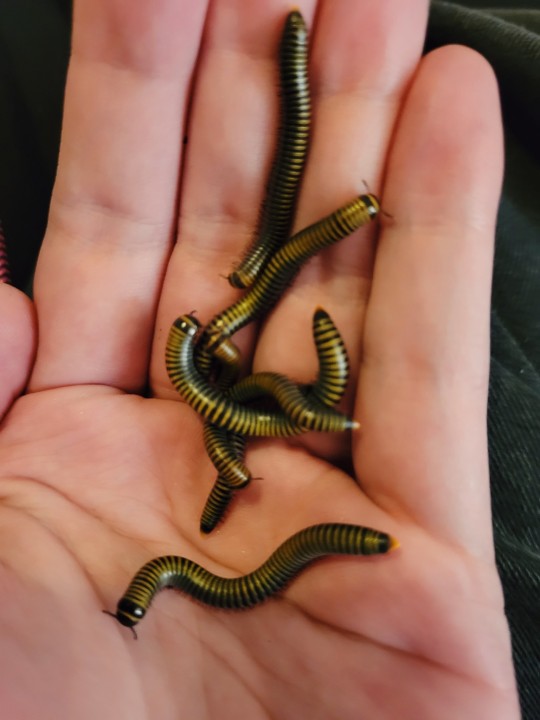
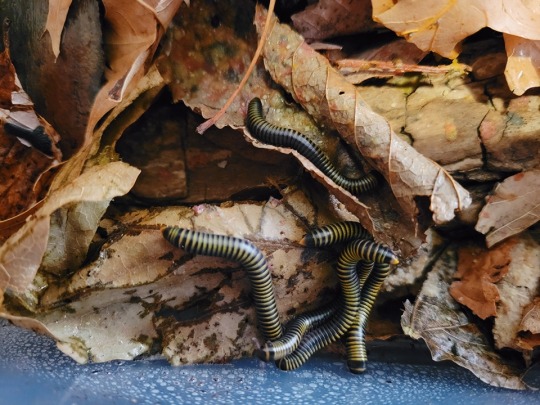
My new pets :) I'm naming this colony The Andrew Sisters, because of my boyfriend lol
#My nickname for him is honeybee#animals#bugs#millipedes#bumblebee millipedes#anadenobolus monilicornis#my posts
0 notes
Text
a bit of biological caution tape:
Anadenobolus monilicornis is a smallish spirobolidan millipede native to the Caribbean. her bright warning coloration is an indicator that a predator who tried to eat her would get a mouthful of noxious fluid containing benzoquinones.
while most A. monilicornis have pinkish legs and antennae, I regularly find a few in introduced populations in Florida with black appendages like this one. cute little things
2K notes
·
View notes
Text
Mil and Peep (bumblebee millipedes - Anadenobolus monilicornis)
[ID: two black and yellow striped bumblebee millipedes in a small box of moss, bark, soil and leaves]
63 notes
·
View notes
Note
Hello, do you happen to know if giant millipedes are an ethical pet? I love millipedes and would love to keep one, but I don’t want to get own if they’re for some reason unethical (taken from the wild, need more than the average pet owner can provide, just don’t do well in captivity, etc) like I know some animals are.
They certainly can be! I can only speak for the US, though, as that's what I'm familiar with in terms of species and laws. In the US, it's illegal to import species that aren't found here, so some of the most readily available "giant" species in the pet trade are Narceus americanus, Narceus gordanus, Chicobolus spinigerus, and Orthoporus ornatus. You can also sometimes still find captive bred African giants that are legal to keep because they weren't imported, but they're rare and expensive. There are also other smaller but still popular species like Trigoniulus corallinus and Anadenobolus monilicornis.
Since the species I mentioned are fairly easy to find in the pet trade, in my opinion it's preferable and more ethical to find sellers who are only selling captive bred millipedes. If the seller does not specifically mention this, I would ask. Usually they will be juveniles if they're captive bred.
As for keeping them in captivity, they do very well, and don't require difficult care at all because they're detrivores who feed on decomposing plant matter, don't need special lights, and can comfortably be kept at room temp.
If you're interested in going furthre with millipede keeping, feel free to IM me and I can give you a more thorough overview on what kind of setup you would need!
91 notes
·
View notes
Text
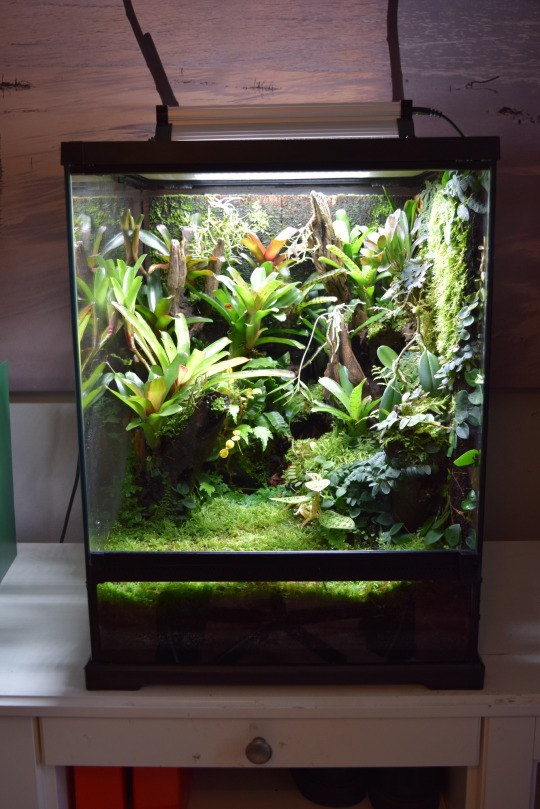

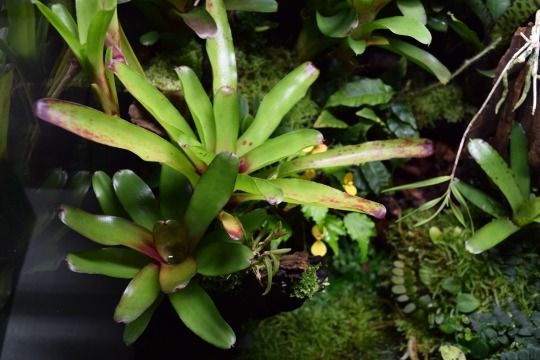
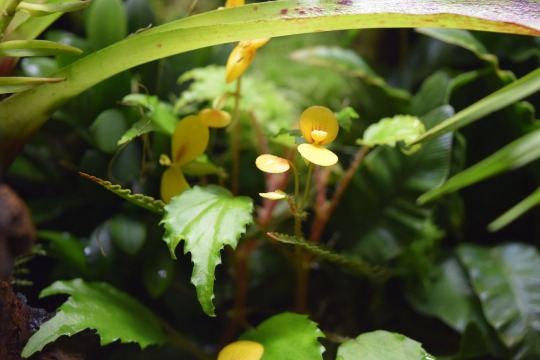
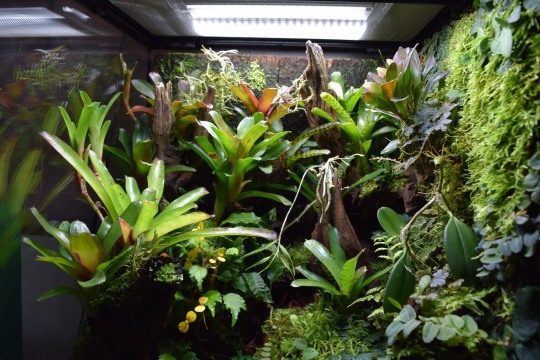
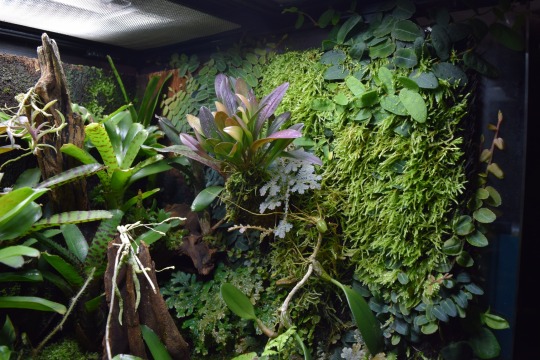
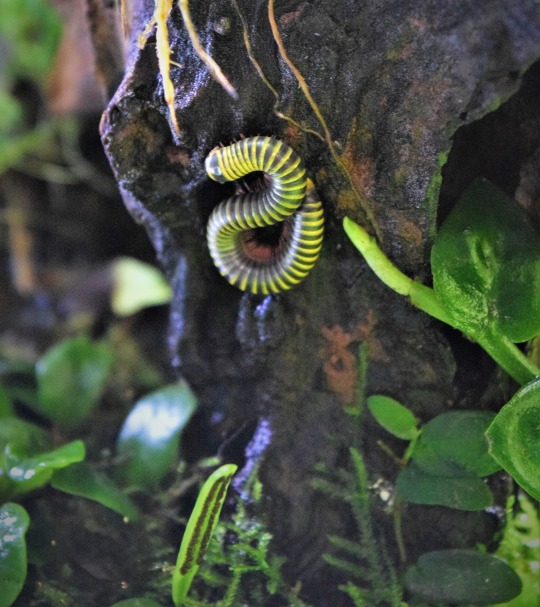
Bumble bee millipede (Anadenobolus monilicornis) enclosure by Wolfgang Dörfler
135 notes
·
View notes
Text
The bugs
Hey there, I'm Ray and I keep mainly millipedes as a hobbiest and I'm still learning a lot about insects.
I have a number of millipedes and will try to keep an up to date list of species here, as well as any I've named 💕
Millipedes
- Gaint Olive/striped Leg(Telodeinpus Aoutii) Adult - Just the one and she's called Shoelace!
-Gaint Olive/striped Leg(Telopedinpus aoutii) juvenile x3
- Thai Rainbow(Apeuthes sp. Thailand) just the one called Rain!
- Spotted Fire(Centrolobus splendidus) x 2
- Gaint Golden(Orthroporus Ornatud) x 3
- Bumblebee(Anadenobolus monilicornis) x 14
- Yellow Dragon(Orthomorpha communis)x1
- Smocky Oak(Narceus gordanus) x1
- Red-Legged (Epibolus pulchripes) x19
- Giant African train(Archispirostreptus Gigas) x3
I have 12 baby millipedes as well! I'll try to ID them once they're bigger and have more colour. But I believe they are spotted reds and MAYBE some bumblebees.
Woodlice/isopods
- Wild caught ??
- Dairy cows 70-100
- Mixed Armadillidium 30+
There's tons of other speices I'd love to get in the future! The new few I plan to get if possible are:-
- Candy Ball pills(Phopalomeris carnifex), such super cute little guys, I believe they're a type of pillbug? Related to millipedes? Got more research to do but I hope to get come soon!
- Ivory Millipedes(Chicobolus spinigerus) their colours are so nice and they're so itty bitty!
- Avatar Millipedes(Apirotreptida sp) I LOVE their yellow legs and feelings, they're the next millipedes I'd like to get once I have the funds for another tank.
- Cameroon rosey leg millipede(Spirostreptidae sp) my friend got some of these and oh I loved them! They're so big and active.
- Coromus Vittatus, a type of flatback Millipede that I've had before and would love another of.
- Purple Ivory Millipede(Chicobolus spinigerus) I just LOVE the purple on them, they're also said to be climbers!
For other plans I want to redo the isopod tanks, get them some nicer tanks with clear glass/plastic so I can see what they're up to.
More sticks and branches in the big tank to the big boys have more to climb on.
Passed pets
- Bark - Coromus Vittatus
I won't be listing any that pass here that I didn't name.
14 notes
·
View notes
Text
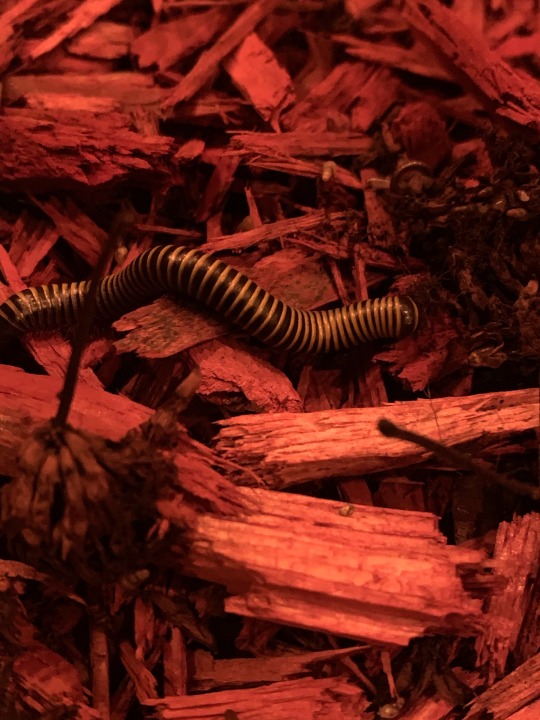
I almost cried. I saw this old guy in one of my plants and I just had to share them. I love millipedes (anadenobolus monilicornis/bumblebee millipede)
3 notes
·
View notes
Text
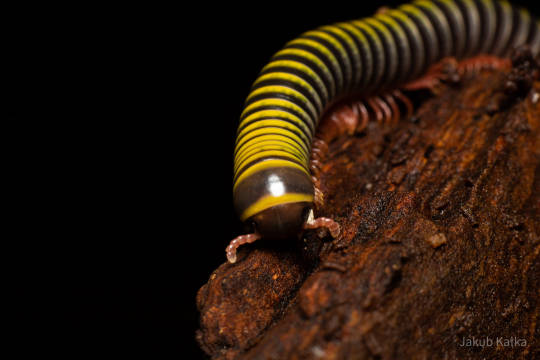

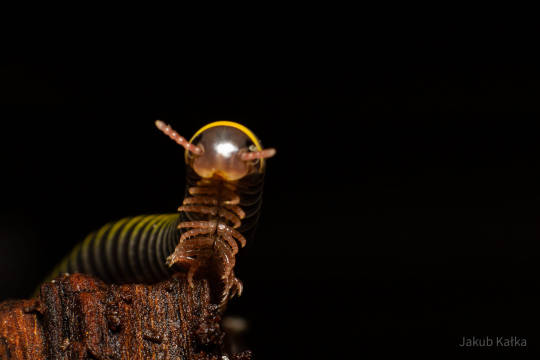
Bumblebee millipede - Anadenobolus monilicornis
Individuals are dark brown with distinctive yellow bands, and measure 2.5–3 centimetres (1.0–1.2 in) long. The legs and antennae are red.
This species inhabits leaf litter. Birds and captive monkeys have been observed crushing these millipedes and rubbing their secretions on their wings or fur, potentially to repel insects. The secretions of millipedes may have some properties that repel insects.
This species is native to the Caribbean: it is found in Brazil, Venezuela, Suriname, Guyana, and on Barbados, Trinidad and Tobago, St. Maarten, Martinique, Dominica, Guadeloupe, Jamaica, Puerto Rico and Haiti.
It species has been introduced to southern Florida, where it can occur in large numbers but is not considered a pest.
4 notes
·
View notes
Text
btw if anyone feels like they have a good grasp on what differentiates anadenobolus monilicornis from other black and yellow millipedes please for the love of god help me fix observations on inaturalist.
its an absolutely massive problem, lots of millipedes are wrongly research-graded to that species all over the world, which then propagates more wrong IDs
you dont have to know what any of them actually are, in fact i suspect many lack any accessible information on how to identify them at all. all you need to do is disagree that they are anadenobolus monilicornis when they are not that but are IDed as such
3 notes
·
View notes
Photo

Speak of the devil, here’s a bumblebee millipede (with A. klugii friend in the top left!) sneaking along the ground of the white lip enclosure. Photo was taken after lights out. I haven’t seen one of these in just over a year, but there are 2 females in this enclosure. Very secretive millipedes. I think I’ve had them for at least 2 years now.
38 notes
·
View notes
Text

Four bumblebee millipedes 😄
#anadenobolus monilicornis#bumblebee millipede#millipede#myriapoda#invertebrates#inverts#bugblr#pets#cute#adorable
6 notes
·
View notes
Note
Hi, I have a question about keeping millipedes as pets! Do they need friends, or do they prefer to live alone? Also, do you know of any good care guides (online or books) for info on how to be the best millipede parent possible? Thank you :)
Hello and welcome!
Millipedes can be kept alone or within a group. They are communal and don't really seem to care how many are around them. They don't fight and just kinda bumble into each other lol. So you can have realistically as many as you can care for in one container. If you keep more than one member of the same species, they could possibly breed and then you'll have a bunch of little millipedes!
Millipedes have nearly identical care instructions to isopods, and I have a handy dandy guide written for them! They require the same type of diet as isopods as in most of their food comes from dead leaves and their substrate. They require a source of calcium and they require places to hide to reduce stress. You can also give them fruit, veggies, and fish flakes/dog food pieces as a supplement to their diets.
There are a couple differences however, and I will list them here.

(Anadenobolus monilicornis Source)
- Millipedes can either thrive in three different environments. Temperate, Tropical, and Desert. Millipedes are adapted to usually one or two of these types of climate and do not like the opposite.
Temperate: Species that are found in the northern parts of the world. These millipedes hibernate through the colder months and like warm and moist (not sopping wet) substrate. They are most active at night. Example species: Narceus americanus

(Source)
Desert: Species that are found in dry parts of the world. These species are used to dry substrate layer on top and a moist and cooler layer below the top. They are used to extreme heat and will shelter from the worst of the heat and during the freezing nights. They are most active at dusk and dawn. Example species: Orthoporus Ornatus

(Source)
Tropical: Species that are found in the warm and wet parts of the world. These species are used to consistent heat and humidity and do not tolerate the cold and dry very well. Some need to be kept at 75+ F in order to thrive. They tend to be day active but will also be active at night. Example species: Chicobolus spinigerus

l (Source)
It's important when getting a millipede to research the type they are and be sure to tailor their enclosure to match what they need. Example, if you have tropical species, it would be a good idea to invest in either a ceramic heat emitter or a heating pad to keep the temperature consistent, and to mist the tank daily to be sure it's humid enough.
Millipedes like water, so you can either spray the sides of the tank so they can drink from the water droplets, or have a bottle cap with water in it, or just keep one corner of the tank wet and they'll drink from the substrate.
Millipedes also need to burrow, so be sure you have at least six inches of substrate they can dig down into. I recommend putting bits of wood in there so they can make chambers where they will molt and rest.
A really good care guide to look at is the one from Bugs in Cyberspace. I get most of my millipedes from this guy so he knows what he's talking about! Awesome :3
You can handle millipedes and they are very gentle. However if startled, some species will extrude a bad smelling chemical that can stain clothes and hands, so be careful if you have sensitive skin! Be sure to wash your hands before and after handling a millipede! Don't be surprised if they nibble on you, they are after your dead skin cells XD
I recommend starting off with a species native to your area, as all you need to do is replicate conditions indoors that they are used to outdoors.
I hope this helps you out, feel free to ask more questions if you need it!!!

#bug stuff#entomology#millipede#millipedes#myriopoda#pet advice#gif#pics#millipedes are my favorite bug species#plz i love talking about my favorite bugs!#care guides
25 notes
·
View notes
Text

Anadenobolus monilicornis, or the bumblebee millipede, in two different color forms. red-legged seems to be the predominant in the invasive populations in Florida where I collected these, but a fair number of females have black legs instead.
316 notes
·
View notes
Photo
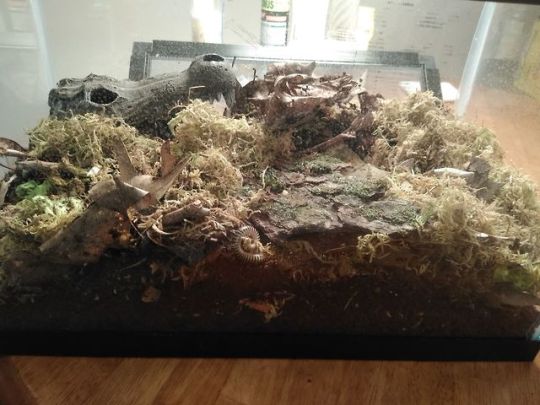
I’ve been making a little vivarium as a fun thing to do and it’s finally complete :0
Size: 5.5 gal zilla critter cage
Substrate: EcoEarth coconut fiber, unscented aspen shavings, dried leaf litter, miscellaneous twigs/bark, and sphagnum moss. Occasionally supplemented with fresh fruit and vegetables, and crushed egg shells for calcium.
Moisture: misted with tap water once per day
Residents:
1 Giant North American Millipede (Narceus americanus)
1 Bumblebee millipede (Anadenobolus monilicornis)
1 Oregon millipede (Tylobolus uncigerus)
1 Eastern Hercules beetle larvae (Dynastes tityus)
3 earthworms
Approximately 20 Greenhouse millipedes (Oxidus gracilis)
Various isopods (pill and sow bugs) (approx 1-2 dozen)
1 flat-back millipede (species unknown, order Polydesmida)
This is what I’m starting out with, the species with sufficient populations might start breeding if they like their home enough :0 But I’m keeping an eye on it to make sure it doesn’t get overrun. I hope the beetle grub grows up big and strong too
16 notes
·
View notes